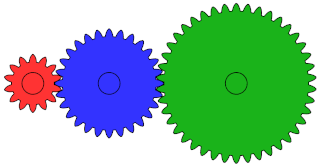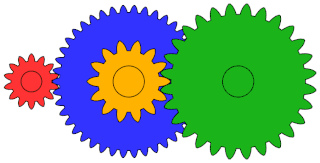Animation Fundamentals: Gears
This subject could constitute an entire website on its own; I've tried my best to highlight just the relevant parts as concisely as possible. Gears are a ubiquitous part of animation. They can serve multiple purposes:
- transfer rotary motion from one point to another (gear train)
- change rotational speed (most often to reduce)
- create visual effects directly
By far they are most often used to reduce motor speed. Motors rotate much too fast for typical animations, so gears bring the RPM down into a useful range. Geared motors—that is, motors with attached gear sets—are the easiest to employ. Making your own gear sets is possible, but it's quite a lot of work owing to the challenge of getting the gears to mesh properly, particularly smaller ones.
There are many types of gears. Those most often encountered in modeling are spur, compound, and worm. Spur gears are most useful for transferring motion from one point to another. Compound gears are essentially pairs of spur gears, which are used in gear reductions. Worms are also used for reduction; a worm/worm gear set can reduce rotational speed substantially, with fewer parts than compound gear assemblies—and much more quietly.

One thing to bear in mind: when using plain spur gears, the final RPM will be a function of the first gear versus the last gear (and if they're the same size, there will be no change at all). All of the rest are just along for the ride, and cannot affect the final RPM. In the above illustration, the blue spur gear could be replaced by a dozen others, and the final RPM will still be a function of the red gear versus the green one.

The only way to achieve greater reduction is with compound gears. Also note that, in virtually every case, the smaller gears drive the larger ones. In both of the above illustrations, the red gears would be motorized, and the green ones would rotate the animated devices.
Other types of gears modelers will encounter include:
- crown gears and bevel gears, which perform the task of changing the rotational axis—usually at right angles—in addition to some speed change
- worm/worm gear sets, efficient at speed reduction, and also very quiet
- ring gears or internal, essentially "inside out" gears where the teeth face inward, most often used in planetary gear sets, which can substantially reduce rotational speed in very compact spaces
- linear gears, a.k.a. racks, which may be found on some steep mountain railways, for instance
There are many more types of gears—helical, spiral, herringbone, etc.—but these aren't typically found in modeling.
As with motors, I have a substantial stockpile of gears accumulated over years of scrounging from old tech like VCRs and small toys. I'm tempted to say one can never have too many gears, especially given that the choice of gears for particular applications can be difficult to assess. This is one of those situations were you need to experiment, and learn along the way.
Practical Application — Gear Train

This long gear train rotates a set of four turbine vents. The small spur gear at the right end is driven; all of the rest are idlers.
Practical Application — Visual Effect

The colorful collection of gears above create the effect of laundromat clothes dryers. Only the blue and green gears are used, since they rotate in the same direction.

Examples
I'd have to list every animated device I've ever made, so here are examples of cases where the gears provide more than just the mundane task of reducing motor speed:
